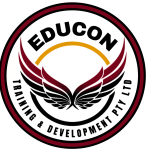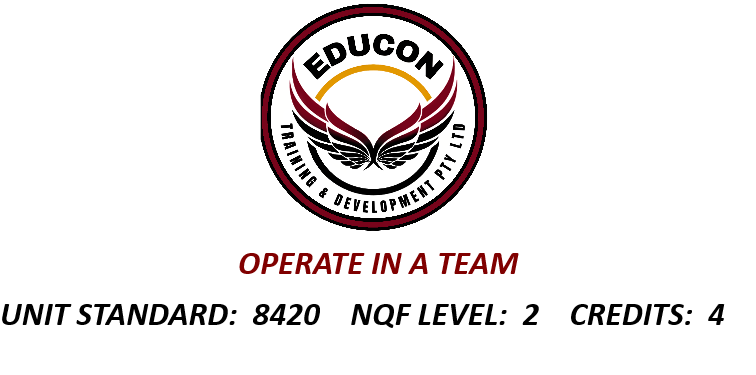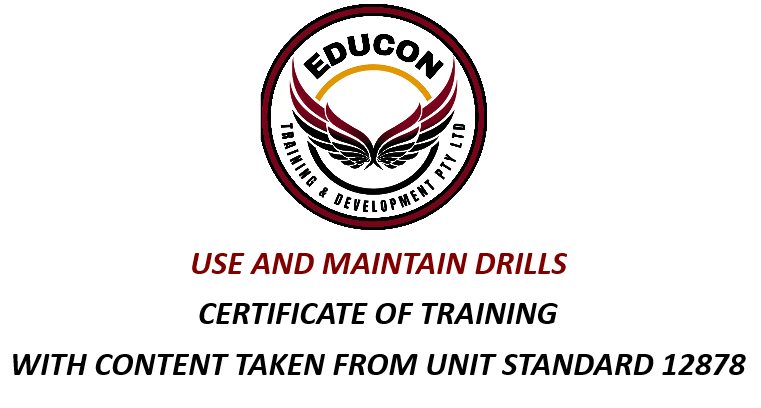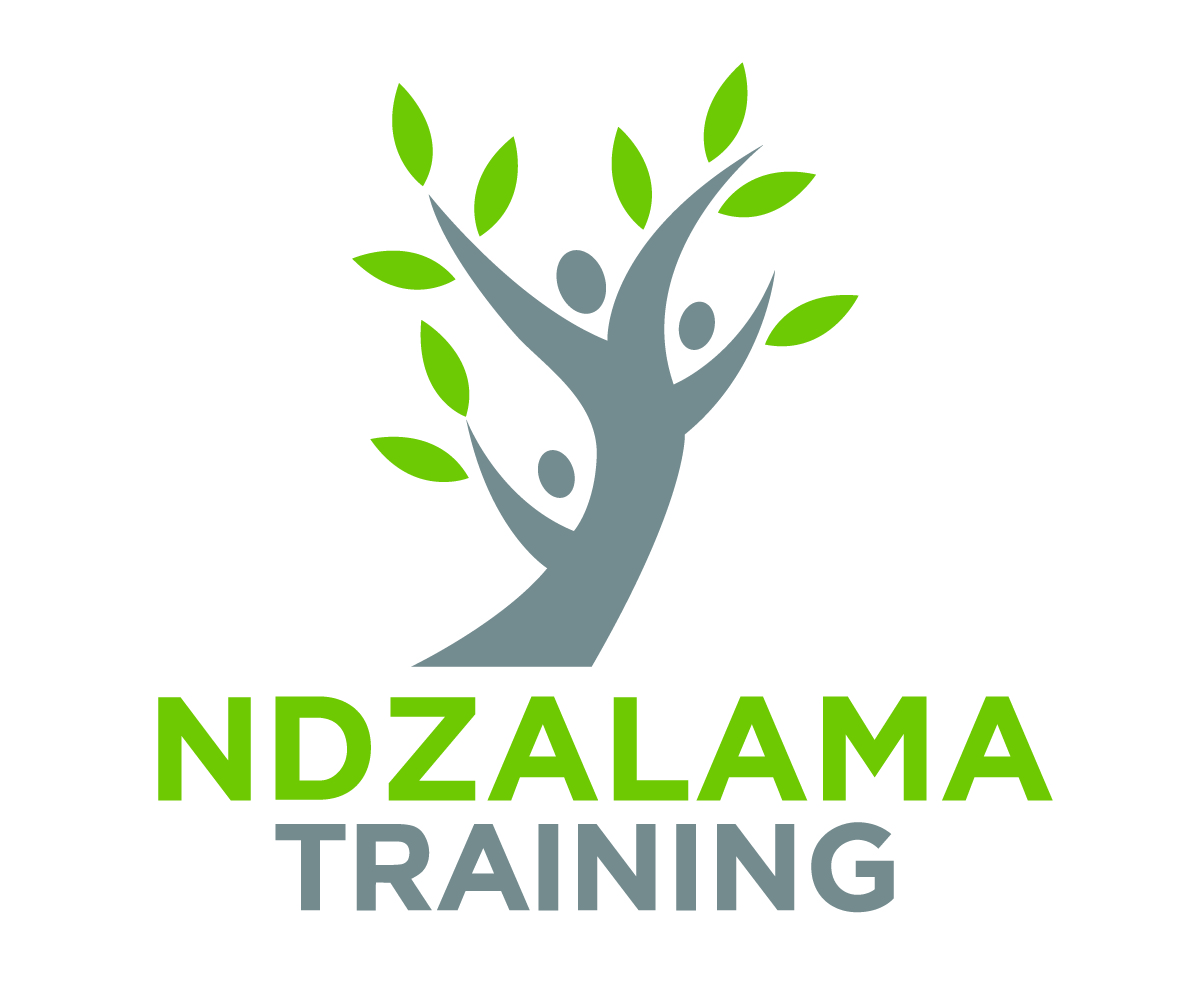A short demonstration course of the platform navigation formulation


A short demonstration course of the platform navigation formulation

Consider the method(s) for collating, recording, storage and retrieval.
Respond timeously and appropriately to the receipt of communications.
Generate communications (e.g. document style).
Select the correct medium to use
Prioritise activities to facilitate an efficient flow of communication.

Use the correct protective clothing and equipment.
Implementing and complying with the relevant procedures.
Implementing selected mechanisms for the minimising of risks.

Explain the concept of coaching in a business environment.
Demonstrate skills and techniques required of a coach.
Develop action plans to coach team members.
Gather evidence and monitor progress.

Use mathematics to plan and control personal, regional and/or national budgets and income and expend
Use simple and compound interest to make sense of and define a variety of situations
Use mathematics to debate aspects of the national economy.

Explain the concept of mentoring
Describe the characteristics of a good mentor.
Explain the importance of knowledge in mentoring.
Apply the skills and techniques required of a mentor
Explain the relevant legal requirements to conduct Occupational Health and Safety (OHS) inspections.
Plan Occupational Health and Safety (OHS) inspections.
Conduct inspections to identify non-compliance in the workplace.
Report on Occupational Health and Safety (OHS) inspections.

Know and understand HIV/AIDS and its effects on the human immune system
Know and understand how HIV/AIDS is transmitted
Know what behaviour is safe and what behaviour carries the risk of HIV transmission.
Know what guidelines and assistance are available to support workers with HIV/AIDS
Know and understand the implications of the HIV/AIDS pandemic

Describe and carry out the roles and responsibilities required to work in a team.
Identify factors affecting a team within workplace and learning environment and explain affect.
Describe the workplace and learning environment organisation.
Review the effectiveness of a team.

Utilise machinery, equipment, materials and time.
Identify and apply goals aligned to the work situation which reflect the organisational goals.
Maintain and enhance organisational image and customer service (both internal and external).
Identify and anticipate customer's requirements
Select and implement the most effective business solution.

Operate within a specific customer service system according to context requirements
Identify customer needs and expectations within specific contexts.
Deal with customer complaints according to specified procedures.
Choose interpersonal behaviours appropriate for occupational situations.

Roadworks Traffic Safety Management
SAIOSH VERIFIED - 5 CPD POINTS

SPECIFIC OUTCOME 1
Explain the principles of advanced first aid in emergencies.
SPECIFIC OUTCOME 2
Demonstrate an advanced level of preparedness to deal with sudden illness or emergency.
SPECIFIC OUTCOME 3
Assess and manage an emergency scene/disaster.
SPECIFIC OUTCOME 4
Describe the anatomy and explain the physiology of the human body systems in terms of injury and sudden illness.
OUTCOME RANGE
Systems: Nervous, cardiovascular, respiratory, muscular-skeletal, integumentary, digestive, genito-urinary and endocrine systems.
SPECIFIC OUTCOME 5
Apply primary first aid life support for adults, children and infants according to accepted current protocols.
OUTCOME NOTES
Appropriately sized manikins and other supporting equipment must be used for the purpose of this assessment.
SPECIFIC OUTCOME 6
Explain the causes of shock and the emergency treatment thereof.
OUTCOME RANGE
Types of shock: Cardiogenic; hypovolaemic and anaphylactic.

NQF LEVEL 3 WITH 8 CREDITS
SPECIFIC OUTCOME 1
Explain the legislative framework governing lifting machines.
OUTCOME RANGE
Occupational Health and Safety Act (85/1993) and Mine Health and Safety Act (29/1996).
SPECIFIC OUTCOME 2
Explain the Driven Machinery Regulations (1988) [DMR] and related Regulations.
SPECIFIC OUTCOME 3
Ensure the safety of self and others.

NQF LEVEL 3 WITH 8 CREDITS
SPECIFIC OUTCOME 1
Describe the physical properties of loads.
SPECIFIC OUTCOME 2
Identify and explain hazardous substances that constitute a load.
SPECIFIC OUTCOME 3
Move and store a hazardous load.

SPECIFIC OUTCOME 1
Demonstrate knowledge of the functions of a crane.
SPECIFIC OUTCOME 2
Identify the safety and suitability of the crane type prior to utilisation.
SPECIFIC OUTCOME 3
Inspect and record the operational fitness of the components of a crane.
SPECIFIC OUTCOME 4
Operate an overhead crane in a safe and competent manner.
SPECIFIC OUTCOME 5
Access available support systems and emergency services in case of incidents and accidents.

NQF LEVEL 2 WITH 4 CREDITS
SPECIFIC OUTCOME 1
Identify types of lifting equipment.
SPECIFIC OUTCOME 2
Inspect and evaluate lifting gear.
SPECIFIC OUTCOME 3
Prepare and sling regular loads.
SPECIFIC OUTCOME 4
Communicate during crane operations.


NQF LEVEL 3 WITH 7 CREDITS
SPECIFIC OUTCOME 1
Apply the recognised methods for inspecting and recording the operational fitness of all components of the lift truck with reference to safety procedure in the workplace.
SPECIFIC OUTCOME 2
Identify and classify freight/loads taking into account documentation, packaging and labelling associated with the specific freight.
SPECIFIC OUTCOME 3
Handle, load and store freight in accordance with industry standards, environmental requirements, and with due consideration to inter alia the commodities and their properties, storage area and placement of load.
SPECIFIC OUTCOME 4
Achieve maximum work performance of lifting equipment and attachments, by applying knowledge of equipment dimensions, controls, principles of operation and capacities, manufacturing specifications and circumstances in the working environment.
SPECIFIC OUTCOME 5
Operate equipment in accordance with laid down organisational and legislative standards and procedures as well as manufacturer's guidelines.
OUTCOME RANGE
Operating includes the actual lifting, stacking manoeuvring, shutting down and parking of the lift truck.
SPECIFIC OUTCOME 6
Access available emergency support systems and services in case of incidents and accidents.

NQF LEVEL 3 WITH 4 CREDITS
SPECIFIC OUTCOME 1
Know and understand HIV/AIDS and its effects on the human immune system
SPECIFIC OUTCOME 2
Know and understand how HIV/AIDS is transmitted
SPECIFIC OUTCOME 3
Know what behaviour is safe and what behaviour carries the risk of HIV transmission.
SPECIFIC OUTCOME 4
Know what guidelines and assistance are available to support workers with HIV/AIDS
OUTCOME NOTES
Know what guidelines and assistance are available to support workers with HIV/AIDS and recognise own role in creating a caring work environment.
SPECIFIC OUTCOME 5
Know and understand the implications of the HIV/AIDS pandemic
OUTCOME NOTES
Know and understand the implications of the HIV/AIDS pandemic for society, the economy, a business sub-sector, an organisation and a specific workplace.

NQF LEVEL 2 WITH 3 CREDITS
SPECIFIC OUTCOME 1
Explain the relevant legal requirements to conduct Occupational Health and Safety (OHS) inspections.
SPECIFIC OUTCOME 2
Plan Occupational Health and Safety (OHS) inspections.
SPECIFIC OUTCOME 3
Conduct inspections to identify non-compliance in the workplace.
SPECIFIC OUTCOME 4
Report on Occupational Health and Safety (OHS) inspections.

NQF LEVEL 4 WITH 3 CREDITS
SPECIFIC OUTCOME 1
Explain the concept of mentoring.
SPECIFIC OUTCOME 2
Describe the characteristics of a good mentor.
SPECIFIC OUTCOME 3
Explain the importance of knowledge in mentoring.
SPECIFIC OUTCOME 4
Apply the skills and techniques required of a mentor.

NQF LEVEL 3 WITH 9 CREDITS
SPECIFIC OUTCOME 1
Utilise machinery, equipment, materials and time.
OUTCOME NOTES
Utilise machinery, equipment, materials and time allocated to the individual cost effectively and productively.
SPECIFIC OUTCOME 2
Identify and apply goals aligned to the work situation which reflect the organisational goals.
SPECIFIC OUTCOME 3
Maintain and enhance organisational image and customer service (both internal and external).
SPECIFIC OUTCOME 4
Identify and anticipate customer's requirements.
OUTCOME NOTES
Identify and anticipate customer's requirements, and meeting those requirements within budget constraints.
SPECIFIC OUTCOME 5
Select and implement the most effective business solution.
OUTCOME NOTES
Select and implement the most effective business solution to problems within his/her own operational environment and level of authority.

NQF LEVEL 3 WITH 5 CREDTIS
SPECIFIC OUTCOME 1
Use mathematics to plan and control personal, regional and/or national budgets and income and expend
OUTCOME NOTES
1.1 Plans describe projected income and expenditure realistically. 1.2 Calculations are carried out using computational tools efficiently and correctly and solutions obtained are verified in terms of the context. 1.3 Budgets are presented in a manner that makes for easy monitoring and control. 1.4 Actual income and expenditure is recorded accurately and in relation to planned income and expenditure. Variances are identified and explained and methods are provided for control.
OUTCOME RANGE
Bank accounts, provincial and key elements of national budgets and tax.
SPECIFIC OUTCOME 2
Use simple and compound interest to make sense of and define a variety of situations.
OUTCOME NOTES
2.1 The differences between simple and compound interest are described in terms of their common applications and effects. 2.2 Methods of calculation are appropriate to the problem types. 2.3 Computational tools are used efficiently and correctly and solutions obtained are verified in terms of the context or problem. 2.4 Solutions to calculations are used effectively to define the changes over a period of time.
OUTCOME RANGE
Effective and nominal rates, commission, appreciation and depreciation.
SPECIFIC OUTCOME 3
Use mathematics to debate aspects of the national economy.
OUTCOME NOTES
3.1 Values are calculated correctly. 3.2 Mathematical tools and systems are used effectively to determine, compare and describe aspects of the national economy. 3.3 Debating points are based on well-reasoned arguments and are supported by mathematical information.
OUTCOME RANGE
Tax, productivity and the equitable distribution of resources.

NQF LEVEL 1 WITH 5 CREDITS
SPECIFIC OUTCOME 1
Demonstrate an understanding of emergency scene management.
SPECIFIC OUTCOME 2
Demonstrate an understanding of elementary anatomy and physiology.
SPECIFIC OUTCOME 3
Assess an emergency situation.
SPECIFIC OUTCOME 4
Apply First Aid procedures to the life-threatening situation.
OUTCOME RANGE
Cardio-Pulmonary (CP) arrest; cessation of breathing; severe haemorrhage.
SPECIFIC OUTCOME 5
Treat common injuries.

NQF LEVEL 3 WITH 5 CREDITS
SPECIFIC OUTCOME 1
Explain the concept of coaching in a business environment.
SPECIFIC OUTCOME 2
Demonstrate skills and techniques required of a coach.
SPECIFIC OUTCOME 3
Develop action plans to coach team members.
SPECIFIC OUTCOME 4
Gather evidence and monitor progress.

NQF LEVEL 2 WITH 4 CREDITS
SPECIFIC OUTCOME 1
Discuss and explain procedures for dealing with fires in the workplace
SPECIFIC OUTCOME 2
Identify the type of fire, its context and select the appropriate fire fighting procedure
OUTCOME RANGE
Types of fires include organic materials/fibre materials, flammable liquids and gases, live electrical equipment, combustible metal fires. Fire contexts include the nature of the area where the fire is, adjacent hazards, structural materials. Methods of fire transmission include conduction, induction, radiation. Combustible hazards include combustible materials and temperatures, compressed containers, electrical equipment, structure and layout of site.
SPECIFIC OUTCOME 3
Identify, select and check appropriate fire fighting and safety equipment
OUTCOME RANGE
Fire fighting equipment includes hoses, extinguishers and buckets. Safety equipment includes breathing apparatus, fire blankets, protective clothing for fire fights, heat shields.
SPECIFIC OUTCOME 4
Fight containable/extinguishable fires
OUTCOME NOTES
Monitor and respond to changes in the fire.
OUTCOME RANGE
Changes in a fire include changes in wind direction, backdraft, ventilation, release of hazardous substances, radiation, or as a result of incorrect application of fire fighting procedures. Fire monitoring issues include status of fire, status of fire fighting equipment, controlling access, structural damage and equipment retrieval, fire fighting casualties.
SPECIFIC OUTCOME 5
Retreat from fire site and hand over to appropriate personnel
SPECIFIC OUTCOME 6
Report/record status of fire and equipment

NQF LEVEL 2 WITH 4 CREDITS
SPECIFIC OUTCOME 1
Identify the structure and purpose of a particular team.
OUTCOME NOTES
Identify the structure and purpose of a particular team in the work place and in the learning environment.
OUTCOME RANGE
SPECIFIC OUTCOME 2
Describe and carry out the roles and responsibilities required to work in a team.
OUTCOME NOTES
Describe and carry out the roles and responsibilities required to work in a team in the workplace and learning environment.
OUTCOME RANGE
SPECIFIC OUTCOME 3
Identify factors affecting a team within workplace and learning environment and explain affect.
OUTCOME RANGE
Description is limited to structure of the organisation.
SPECIFIC OUTCOME 4
Describe the workplace and learning environment organisation.
OUTCOME NOTES
Describe the workplace and learning environment organisation and identify its influence on team members and team.
OUTCOME RANGE
Description is limited to structure of the organisation.
SPECIFIC OUTCOME 5
Review the effectiveness of a team.
OUTCOME NOTES
Review the effectiveness of a team and own participation in the team within the workplace and learning environments.
OUTCOME RANGE
Description is limited to structure of the organisation.

NQF LEVEL 3 WITH 8 CREDITS
SPECIFIC OUTCOME 1
Use the correct protective clothing and equipment.
OUTCOME NOTES
Use the correct protective clothing and equipment in relation to specific freight/commodities and environments.
SPECIFIC OUTCOME 2
Implementing and complying with the relevant procedures.
OUTCOME NOTES
Implementing and complying with the relevant procedures, material requirements and methodologies in maintaining prescribed safety, health and environmental standards in the workplace (e.g. ensure cleanliness, report faulty equipment).
SPECIFIC OUTCOME 3
Implementing selected mechanisms for the minimising of risks.
OUTCOME NOTES
Implementing selected mechanisms for the minimising of safety, health and environmental impacts and risks as specified in current legislation (e.g. Occupational Health and Safety Act), NOSA requirements and organisational policies (e.g. removal of waste).

NQF LEVEL 2 WITH 4 CREDITS
SPECIFIC OUTCOME 1
Consider the method(s) for collating, recording, storage and retrieval.
OUTCOME NOTES
Consider the method(s) for collating, recording, storage and retrieval of information and workplace records.
SPECIFIC OUTCOME 2
Respond timeously and appropriately to the receipt of communications.
OUTCOME NOTES
Respond timeously and appropriately to the receipt of communications and the dissemination of information to internal and external customers (written, verbal, and/or electronic).
SPECIFIC OUTCOME 3
Generate communications (e.g. document style).
OUTCOME NOTES
Generate communications (e.g. document style) in accordance with prevailing organisational and industry requirements and norms.
SPECIFIC OUTCOME 4
Select the correct medium to use.
OUTCOME NOTES
Select the correct medium to use in the generation, handling and processing of documents and communication (e.g. e-mail, Internet, fax).
SPECIFIC OUTCOME 5
Prioritise activities to facilitate an efficient flow of communication.
OUTCOME NOTES
Prioritise activities to facilitate an efficient flow of communication and documentation for the enhancement of the organisation's image.
SPECIFIC OUTCOME 6
Conduct the reception and referral of visitors and/or clients in a courteous and hospitable manner.

NQF LEVEL 3 WITH 2 CREDITS
SPECIFIC OUTCOME 1
Reflect on personal use of time in order to plan a balanced lifestyle.
SPECIFIC OUTCOME 2
Research aspects of a balanced lifestyle and their relationship to productivity.
SPECIFIC OUTCOME 3
Investigate tools and techniques to manage time.
SPECIFIC OUTCOME 4
Apply knowledge of time management to enhance own productivity and lifestyle.


Upon completion qualifying learners will be able to work in one of the following home-care and/or related settings:
Module 1 - Professional practice and ethics
Module 2 - Nutrition and food preparation
Module 3 - Infection Control
Module 4 - Introduction to anatomy and physiology
Module 5 - Geriatric psychology
Module 6 - Practical procedures


Professional Practice and Ethics
Nutrition and Food Preparation
Infection Control
Introduction to Anatomy and Physiology
Geriatric Psychology
Primary Health Care
Practical Procedures

In our society today people seem to have lost their ability to communicate with each other. And with communicate we mean either verbally or for the hearing impaired, with sign language.
Technology has robbed us of the subtle art of verbal communication. This course addresses these needs in society.

One of the duties as a PA/ Secretary/ Office Administrator might very well include taking minutes and arranging meetings.
The thought of the above usually fills the person with anxiety at the prospect. Questions like the below might come up:

Basic user course on the use of the following Microsoft Office applications:
Microsoft Word
Microsoft Excel
Microsoft Power Point

As a woman in the mining industry, ask yourself the following questions:
This course attempts to answer the above concerns.

A course for ladies about appropriate behavior and professionalism in the workplace

Identify assertive behaviour and discuss the advantages.
Understand the importance of assertiveness as an important tool to use to communicate effectively.
Use different techniques to be assertive.
Understanding the value of assertive behaviour.

Demonstrate knowledge and basic understanding of human anatomy.
Demonstrate knowledge and basic understanding of physiology.
Demonstrate knowledge and basic understanding of pathology.

A permit-to -work system is a formal written system incorporated with the company QMS used to control certain types of work that are potentially hazardous.
These permits go hand-in-hand with lockout and tag-out procedures.
This course provides the learner with the necessary information to enable him/her to ensure their safety when performing hazardous tasks.

Training on the spread of the Corona Virus and what measures you need to put in place in the workplace to keep your employees as safe as possible from contracting the virus.
Material compiled and taken from the Government and international forums on this virus

The Occupational Health and Safety Act 85, 1993, requires the employer to bring about and maintain, as far as reasonably practicable, a work environment that is safe and without risk to the health of the workers. This means that learners need to be made aware of the dangers and risks surrounding them at work.
As part of the above Induction training is done at most companies.
This is a course with content taken from US 259639 to introduce the learner to these aspects.

The purpose of this course is to train learners in the hazards and risks associated with confined space entry.
It is sometimes required for employees to enter a confined space to do maintenance or repair equipment.
The OHS Act 85, 1993, General Safety Regulations have specific specifications that dictate the procedures of confined space entry in the workplace.

Describe the framework of workplace health and safety legislation pertaining to health and safety representatives.
Explain the specified requirements to conduct safety, health and environmental representation activities at a working place.
Address safety, health and environment related issues within the scope of authority.
Comply with the activities within safety, health and environmental structures.

Discuss different types of emergencies that may be encountered in a workplace.
Explaining emergency preparedness and demonstrating response appropriate to the situation.
Duties of a warden and the planning processExplain actions required of a safety officer in an assembly area.
Procedures to account for all evacuated parties are explained in accordance with safety and workplace procedures.
Demonstrate knowledge pertaining to the definition of fire, principles and chemistry of combustion.
Demonstrate knowledge pertaining to the main causes of fire, fire spread and the principles of heat transmission.
Demonstrate knowledge pertaining to the effects of fire and the different methods of fire spread control in the workplace.
Demonstrate knowledge pertaining to the classification of fires, the appliances to control fires and methods of detection.

Explain the specified requirements pertaining to conducting an investigation into workplace incidents.
Prepare to gather data for the investigation.
Gather and evaluate data.
Perform post-investigation functions.

Explain the legal and specified requirements for conducting continuous risk assessments.
Prepare to conduct a continuous risk assessment.
Conduct a continuous risk assessment.
Initiate remedial action and follow up on Continuous Risk Assessment.

Monitor, advise and report on the scope and understanding of the specified requirements as regards to hazardous substances in a work place.
Demonstrate knowledge pertaining to the application of methods in preventing exposure to hazardous substances in a work place.
Demonstrate knowledge pertaining to the classification, physical state, health effects and disposal methods of hazardous substances in a workplace.


This course teaches the learner:

Employees do not always feel comfortable talking to their employers about their Wellness situation.
Total Wellness: = Physical, emotional, spiritual, social, financial, occupational, environmental, intellectual wellness.
A Wellness Champion and peer educator is a person in the company or department that keeps employees informed (toolbox talks, notices, posters etc.) regarding all of the above. It is also the person that builds a personal relationship with his/her peers in the workplace, a person people feel comfortable with. Most of all it will usually be the Wellness Champion that will be the first to notice that something is amiss with a fellow employee, lets call it a "front line defense" on your employees wellness.

Use and maintenance of:
Drills
Handheld electrical, handheld cordless, bench press drills

NQF LEVEL 6 WITH 10 CREDITS
SPECIFIC OUTCOME 1
Demonstrate understanding of moderation within the context of an outcomes-based assessment system.
SPECIFIC OUTCOME 2
OUTCOME RANGE
The planning and preparation is to take place within the context of an existing moderation system, whether internal or external, as well as an existing assessment plan.
SPECIFIC OUTCOME 3
Conduct moderation.
OUTCOME RANGE
- The moderation process confirms the assessment results, and where
- The moderation process finds it cannot uphold the assessment results
SPECIFIC OUTCOME 4
Advise and support assessors.
SPECIFIC OUTCOME 5
Report, record and administer moderation.
SPECIFIC OUTCOME 6
Review moderation systems and processes.

NQF LEVEL 5 WITH 15 CREDITS
SPECIFIC OUTCOME 1
Demonstrate understanding of outcomes-based assessment.
SPECIFIC OUTCOME 2
Prepare for assessments
SPECIFIC OUTCOME 3
Conduct assessments.
OUTCOME RANGE
The ability to make assessment judgements using diverse sources of evidence must be demonstrated. Assessments to include cases where candidates have special needs and where evidence arises through RPL situations. Should it not be feasible to gather evidence for assessments of special need candidates or in RPL situations, evidence may be produced through scenarios
Candidate-assessors must show they can make judgements in situations where:
SPECIFIC OUTCOME 4
- Candidates meet all criteria in relation to an outcome,
- Candidates clearly do not meet the criteria in relation to an outcome,
- Candidates meet some, but not all criteria, and
- More evidence is required before a judgement is possible.
SPECIFIC OUTCOME 5
Review assessments.
OUTCOME RANGE
The review should address at least the following aspects:

NQF LEVEL 5 WITH 10 CREDITS
SPECIFIC OUTCOME 1
Plan and prepare for facilitation.
SPECIFIC OUTCOME 2
Facilitate learning.
SPECIFIC OUTCOME 3
Evaluate learning and facilitation
